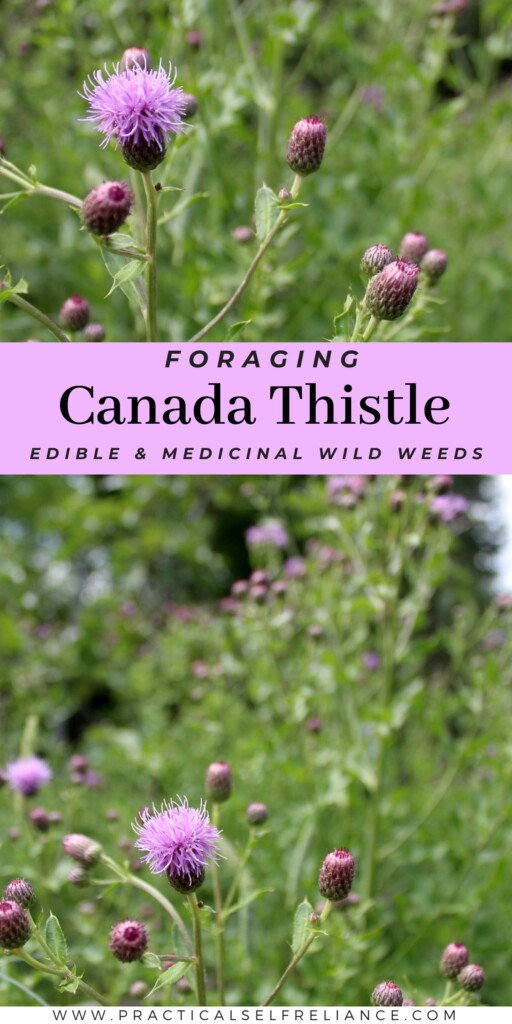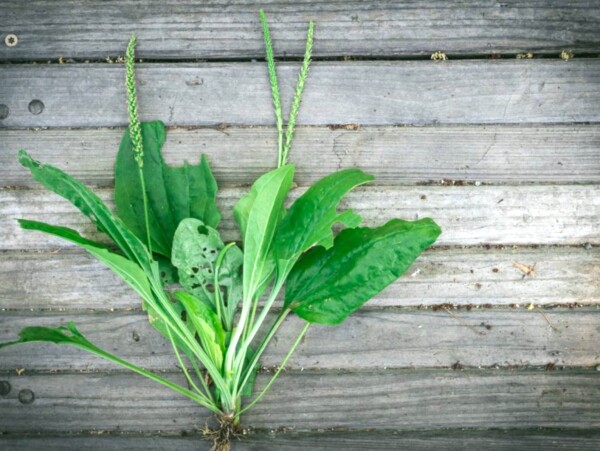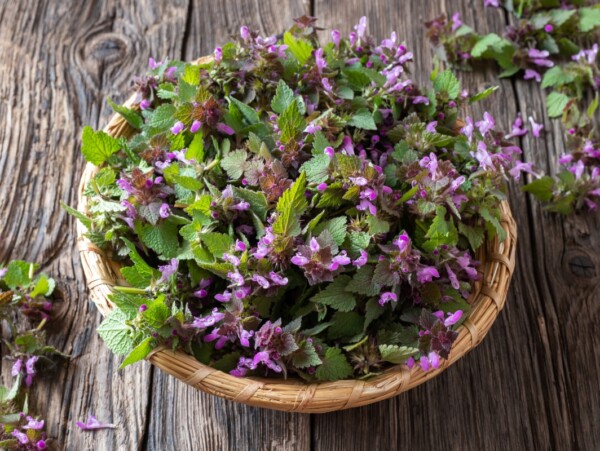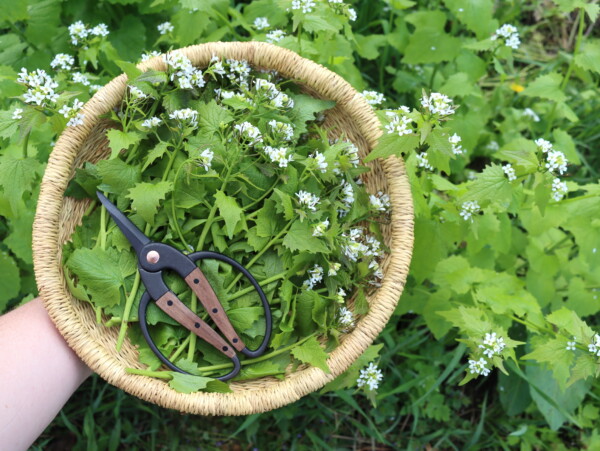Affiliate disclosure: This post may contain affiliate links. Please see our Privacy Policy.
Canada Thistle (Cirsium arvense) is an incredibly invasive, spiky weed, but it’s also an edible and medicinal plant. One of the best ways to control this prickly menace is to eat it!
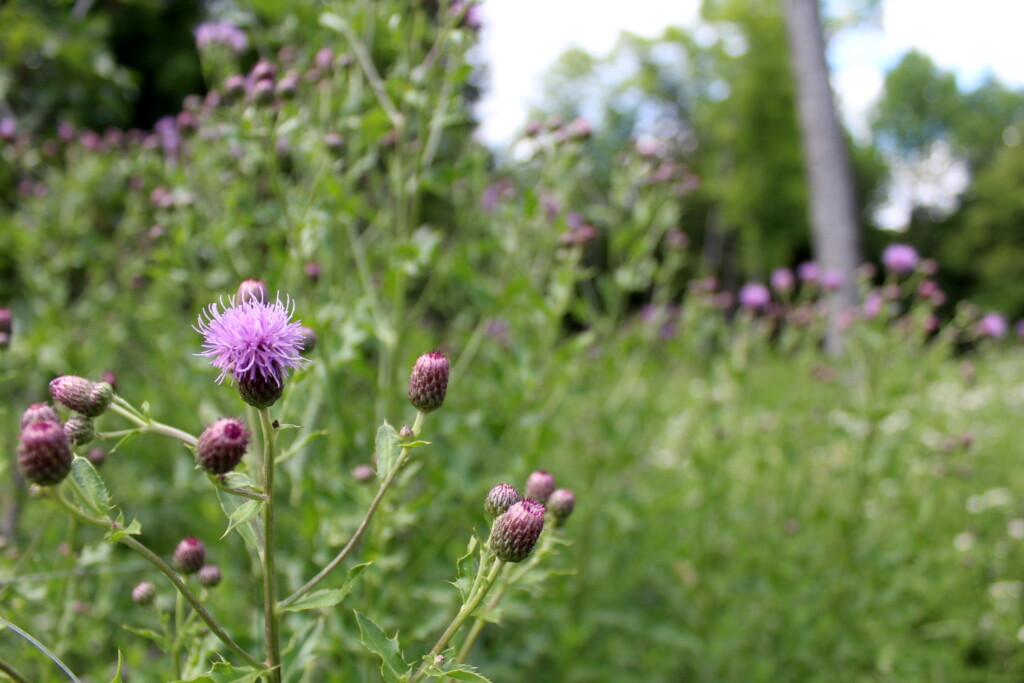
Table of Contents
- What is Canada Thistle?
- Is Canada Thistle Edible?
- Canada Thistle Medicinal Benefits
- Where to Find Canada Thistle
- When to Find Canada Thistle
- Identifying Canada Thistle
- Canada Thistle Leaves
- Canada Thistle Stems
- Canada Thistle Flowers
- Canada Thistle Roots
- Canada Thistle Seeds
- Canada Thistle Look-Alikes
- Ways to Use Canada Thistle
I’ll admit, I like most plants, but this one’s hard to love. It’s agressive, spiky and produces thousands of seeds per plant. They’re wind spread, so they get everywhere, a bit like dandelions…but sharp and six feet tall.
As a gardener and someone who like to walk barefoot in the yard, they’re a menace. But, the bees love them. Absolutely can’t get enough of them.
And they’re edible, blossom to root.
So I put on my shoes, and a few stout gardening gloves, and set out to see the beauty in these spiky devils.
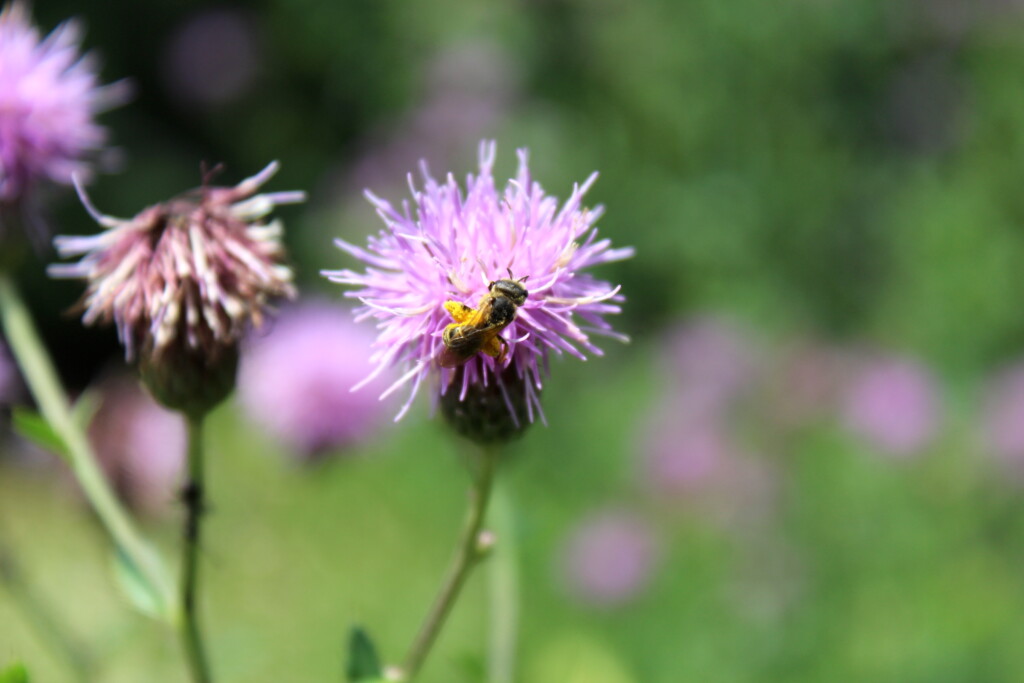
What is Canada Thistle?
Canada Thistle (Cirsium arvense) is an herbaceous perennial in the Asteraceae or Aster family. Depending on where you live, you may also hear it called Field Thistle, Canadian Thistle, Small-Flowered Thistle, Corn Thistle, Cursed Thistle, Hard Thistle, Lettuce from Hell Thistle, Stinger-Needles, Way Thistle, Setose Thistle, Green Thistle, or Creeping Thistle.
It’s native to Europe, western Asia, and northern Africa but has naturalized worldwide, especially in the Northern US and Canada.
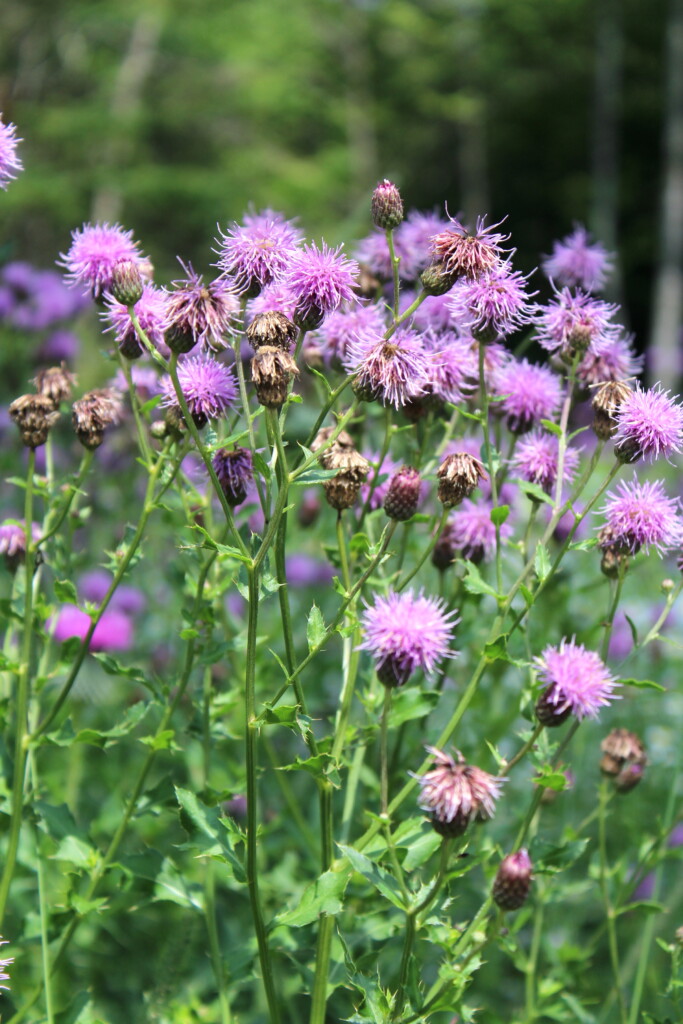
Is Canada Thistle Edible?
Canada Thistle is edible but isn’t widely used. You can eat the roots, leaves, stalks, and flower buds. The leaves and stalks are best when young. Many foragers consider the stems to be the easiest and most worthwhile part of the plant to harvest and use.
The sharp spines can make processing leaves time-consuming. Some folks find that they can tolerate the spines of young leaves if they are cooked or blended and that they can even be rolled up and eaten raw.
The roots are considered the most nutritious part of Canada Thistle but are reportedly high in inulin, a starch indigestible to humans. It’s believed that inulin begins to ferment and causes flatulence in some people. If you’ve never tried Canada Thistle before and are sensitive to other plants, starting with a small amount may be best.
You can also harvest the inner part of the flower buds. These are similar to the related Globe Artichoke in flavor and texture but are a lot of work to gather and process and are much smaller than their domesticated relative.
Additionally, you can harvest Canada Thistle for medicinal use. Herbalists generally harvest the roots and flowers for various internal applications.
Agricultural experts believe that Canada Thistle produces nitrate, which can be toxic to horses and cattle when consumed in large quantities.
Historically, Canada Thistle has been used as an emmenagogue to induce menstruation. Anyone who is pregnant or breastfeeding should avoid Canada Thistle and consult with their medical practitioner.
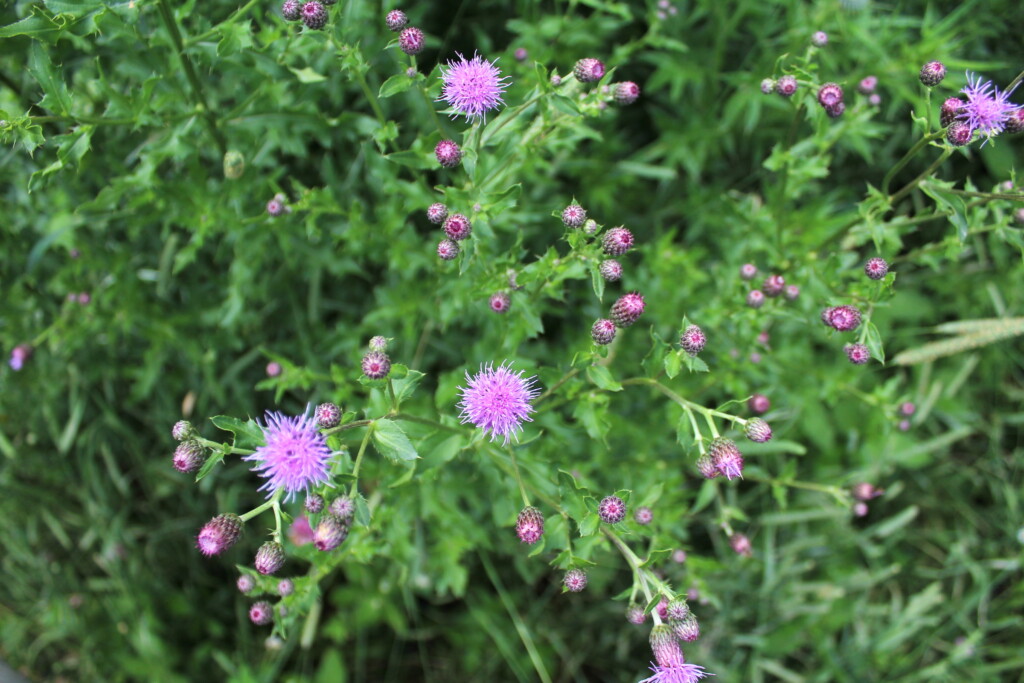
Canada Thistle Medicinal Benefits
Throughout history, many herbalists have employed Canada Thistle in remedies, particularly the roots. Canada Thistle is believed to have hepatic, anti-inflammatory, astringent, diuretic, emetic, and emmenagogue properties.
Herbalists sometimes use a paste made from the roots to treat indigestion, and a decoction of the roots to treat worms in children. The roots were also chewed as a toothache remedy, and used as a mouthwash for infants (for teething pains, of course).
Scientists have found that some of Canada Thistle’s value in traditional medicine may come from its antioxidant compounds. One study found that Canada Thistle is particularly high in phenolic compounds, especially quercetin, which may account for some of its medicinal benefits.
Another study examined the compounds found in an extract of the Canada Thistle flower. Researchers identified seven compounds which are believed to possess anti-inflammatory, antimicrobial, antidiabetic, antioxidant and/or anticancer activities. A separate 2013 study also found Canada Thistle to contain compounds with anti-fungal and antibacterial properties.
A 2018 study also explored the effects of climate and soil on the essential oil production of Canada Thistle. Interestingly, the highest essential oil contents were found in plants growing in clay soils, indicating that these might be the best growing conditions if you’re foraging or growing Canada Thistle for medicinal use.
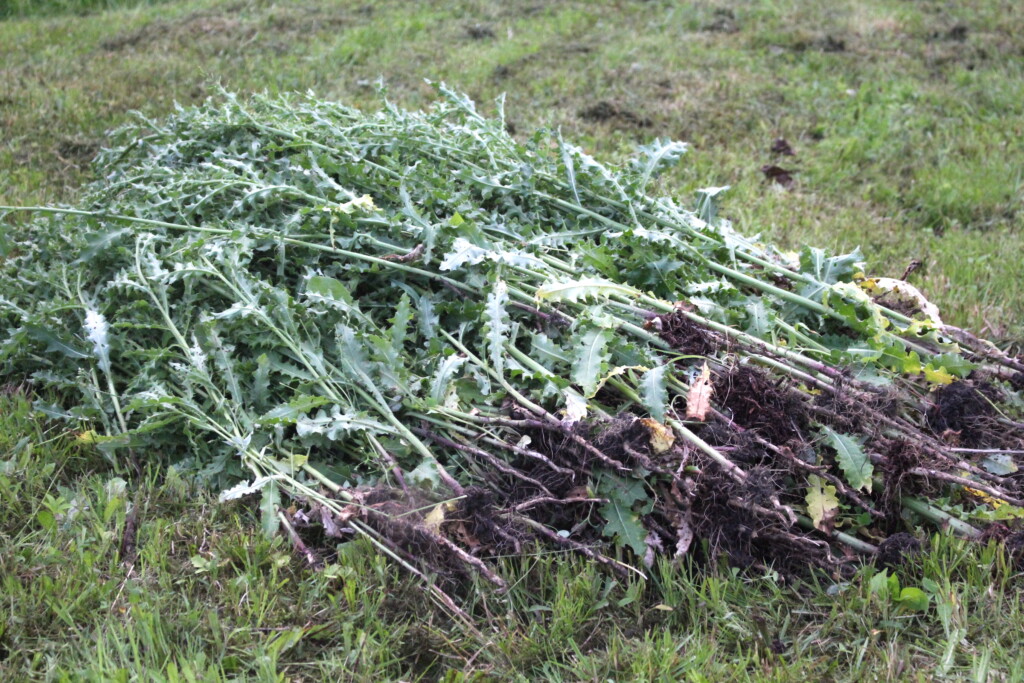
Where to Find Canada Thistle
Originally native to Europe, western Asia, and northern Africa, Canada Thistle has naturalized worldwide. In fact, it’s considered to be one of the worst invasive weeds in the world.
Given this, it’s no surprise that Canada Thistle is highly adaptable. It will tolerate various soil conditions in dry to moist habitats. It can even grow in areas with 2% salt content in the soil. However, Canada Thistle isn’t tolerant of shade and thrives best in sunny, disturbed habitats.
You may spot Canada Thistle in riparian areas, waste places, pastures, cultivated fields, yards, grasslands, glades, and open woodlands. It’s often most abundant around human activity.
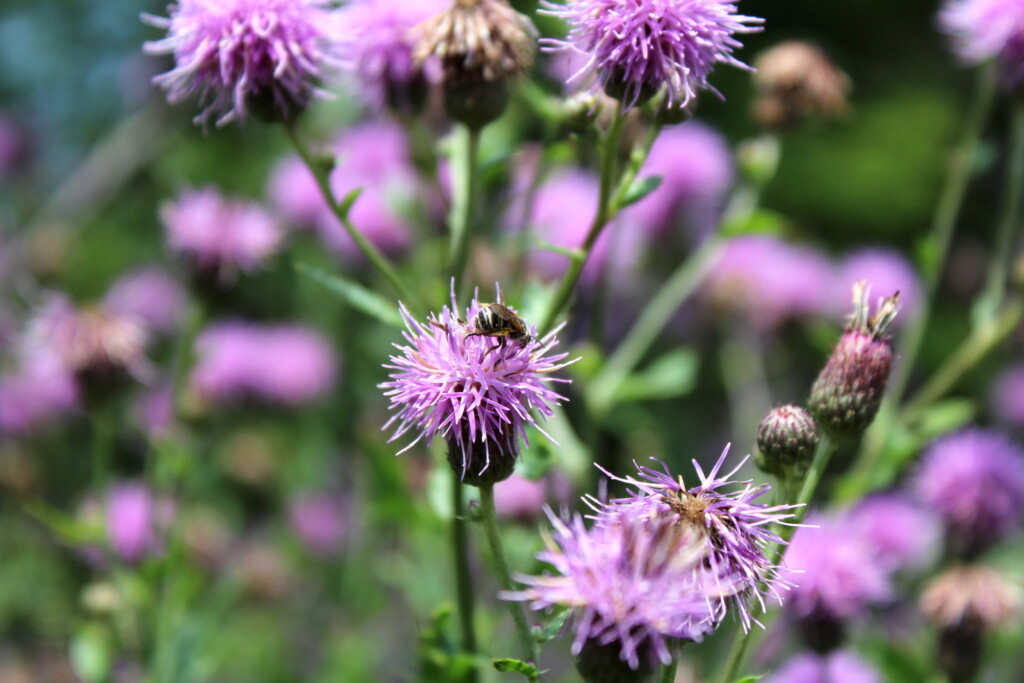
When to Find Canada Thistle
Canada Thistle usually dies back in the fall and emerges from its root system in mid to late spring as a basal rosette of leaves. New plants, growing from seed, germinate around this same time.
In colder habitats, this generally occurs in April or May, but you may spot it earlier in warm, southern climates. Additional flushes of plants may occur during the summer and fall when soil moisture is adequate.
Canada Thistle is triggered to flower when the day length reaches 14 to 16 hours in late spring or summer, depending on your location.
Identifying Canada Thistle
Canada Thistle begins as a basal rosette of deeply-lobed, spiny leaves. Many unfortunate souls locate them while barefoot. Then they grow into an erect, herbaceous plants typically found in dense colonies.
Canada Thistle reproduces through two methods. It forms seeds with a parachute-like pappus which allows them to wind-disperse. It also spreads vegetatively through lateral roots and root segments and can quickly colonize a disturbed habitat.
It’s often easiest to spot when it’s in flower. You may spot its purple to white blooms in late spring through summer, often between June and August.
Canada Thistle Leaves
Canada Thistle has dark green, smooth, lance-shaped, irregularly lobed leaves that are 2 to 6 inches long. They may have weakly or strongly prickled margins and have prominent midribs.
The leaves form a rosette at the base and are alternately arranged on the stem. They are sessile, lacking stalks, and may directly clasp the stem or be shortly decurrent.
Canada Thistle Stems
Canada Thistle has ridged, hairy stems up to 4 feet tall. They may be green to purplish and often branch near the top.
Canada Thistle Flowers
Canada Thistle blooms when the day length is between 14 and 16 hours. Depending on the location, this is often in late spring or summer, usually from June to August here in the United States.
Canada Thistle blooms are composite clusters of white to purple florets held and protected by thorn-bearing bracts. They’re generally about 1 inch long and 1/2 an inch wide. Their shape resembles that of an old-fashioned shaving brush.
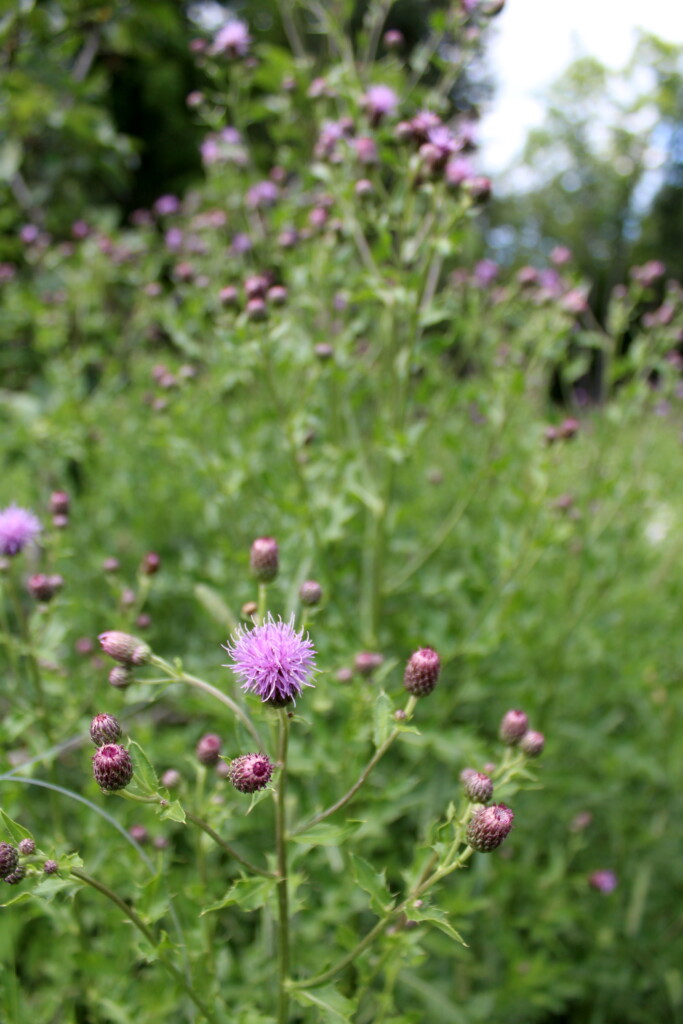
Canada Thistle Roots
Canada Thistle has an extensive, fibrous, fast-growing root system. This root system may be up to 15 feet wide and deep.
When you pull them, you often just get the central piece, not the whole root system.
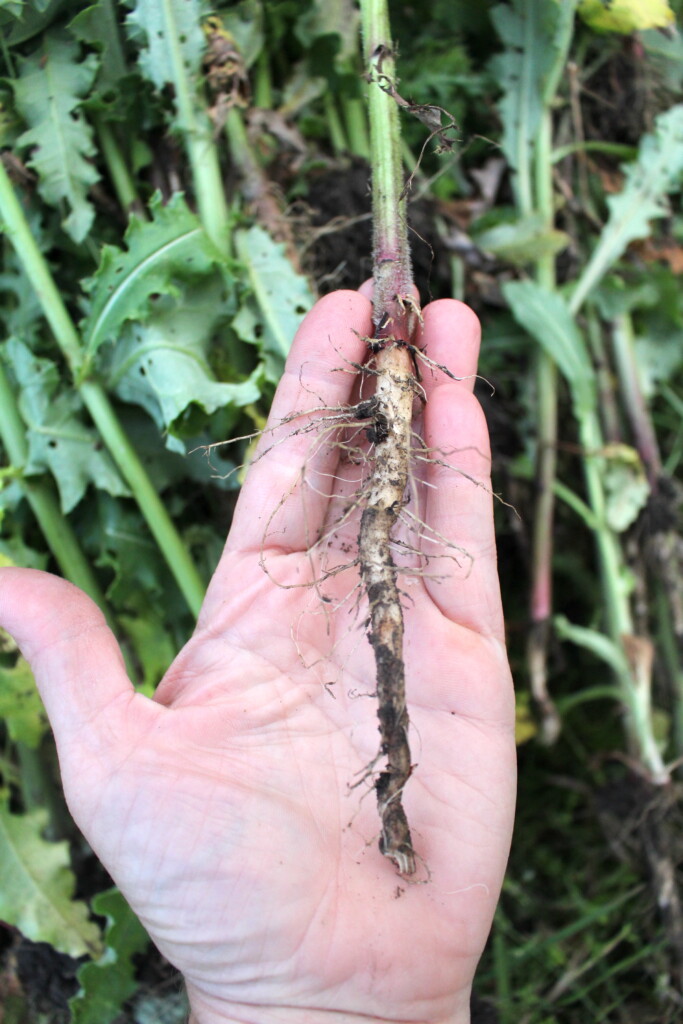
Canada Thistle Seeds
The flowers give way to small, soft, brown seeds or achenes that are somewhat banana shape. Each seed is attached to a feathery pappus, allowing them to wind disperse.
The seed is typically only about 0.1 inches long, but the entire structure may be 1 to 1 1/2 inches long.
Canada Thistle Look-Alikes
Canada Thistle is sometimes mistaken for the related and also edible Bull Thistle (Cirsium vulgare). However, Bull Thistle differs in several noticeable ways:
- Bull Thistle is typically larger growing up to 6 feet tall.
- Bull Thistle tends to have a single flower stem which is only branched near the tip.
- Bull Thistle has a more distinct, single taproot.
- Bull Thistle flowers are larger, usually about 1 to 2 inches wide.
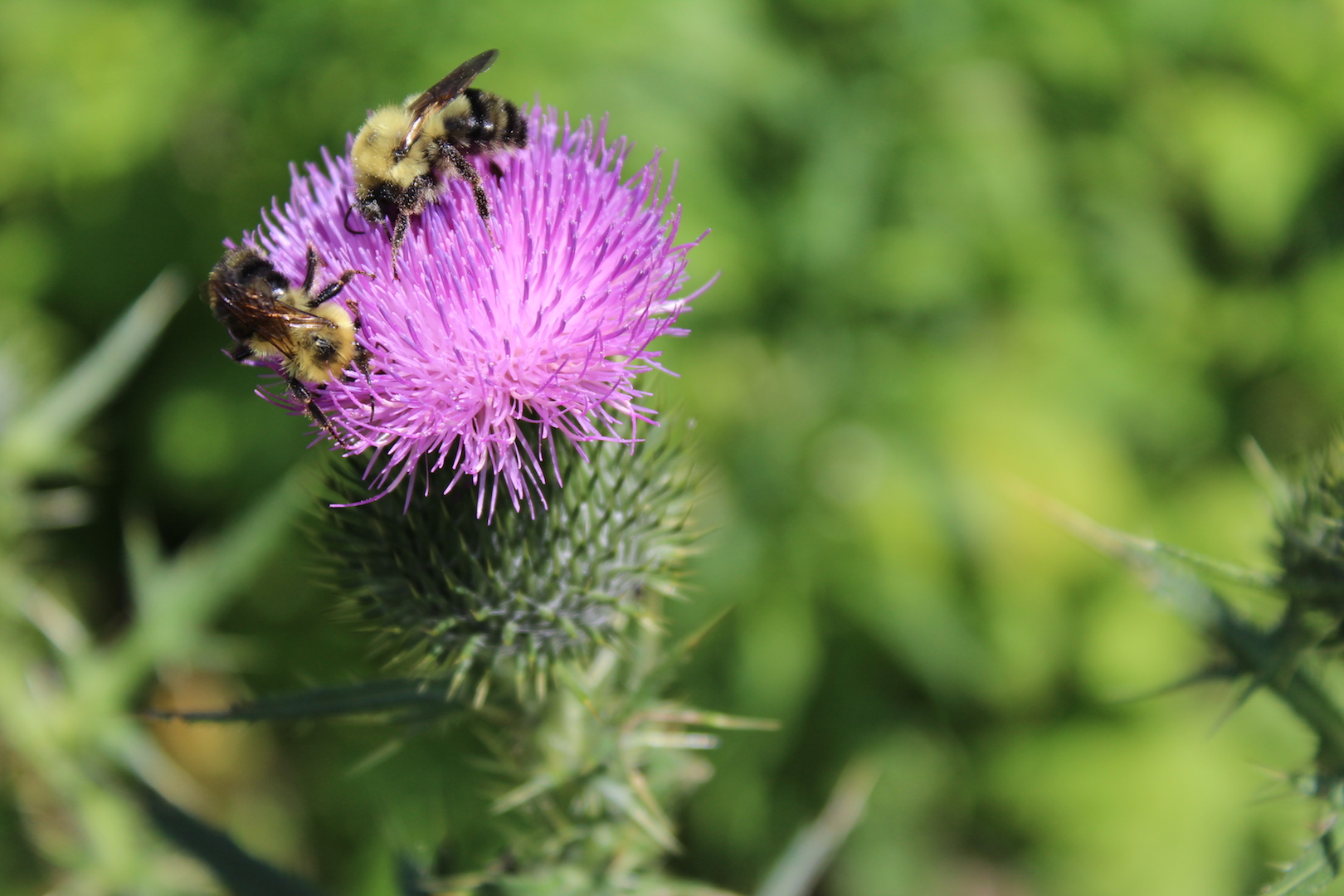
Another lookalike is Greater Burdock (Arctium lappa). Fortunately, it too differs in a few easy-to-spot ways:
- Greater Burdock can reach 10 feet tall.
- Greater Burdock has large, wavy-edged, heart-shaped leaves that lack spines.
- Greater Burdock has a large, fleshy taproot growing up to 3 feet 3 inches long.
- The flowers of Greater Burdock are more globe-shaped, and the spines on their bract have hooked tips.
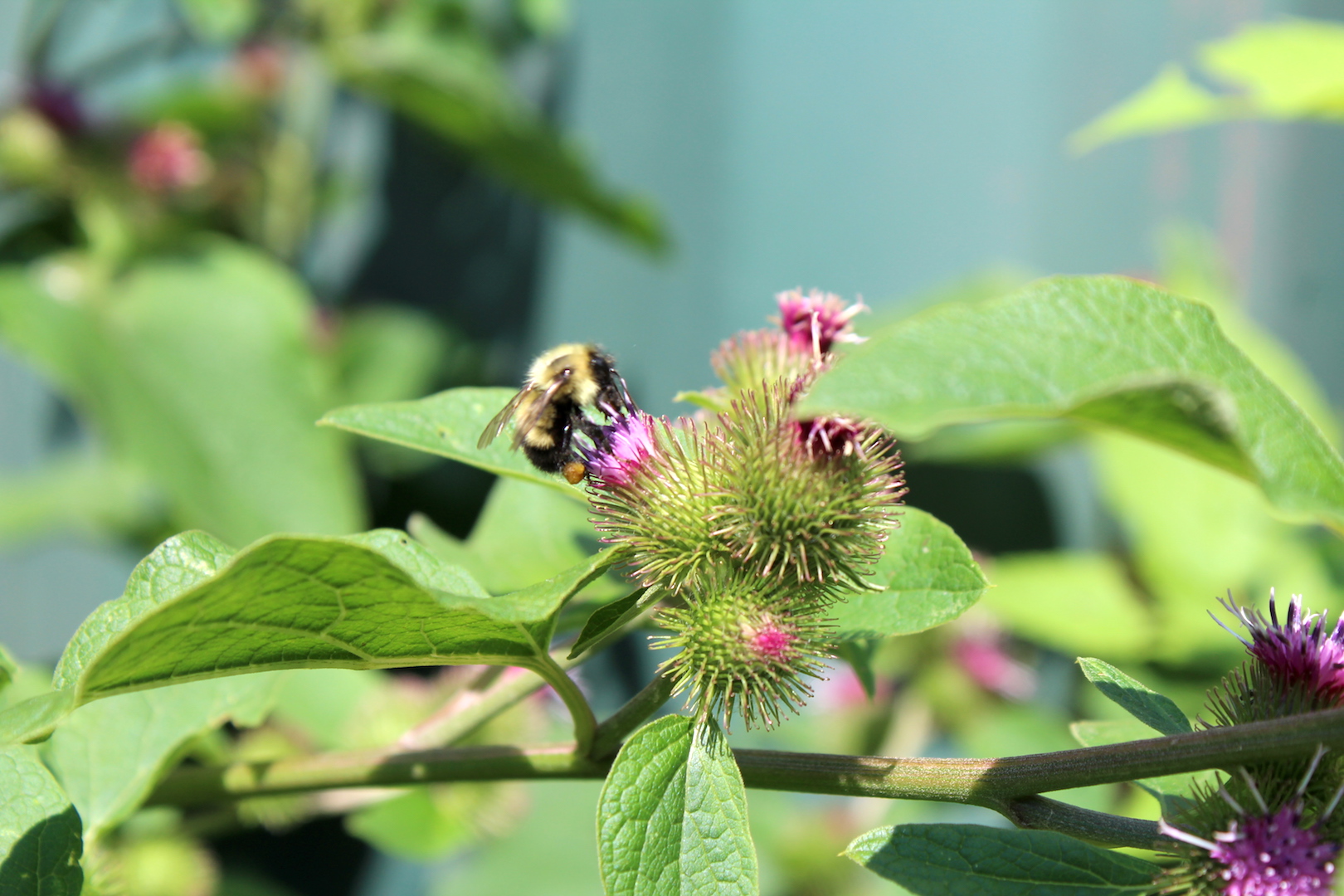
Lastly, Canada Thistle can be mistaken for another purple flowered weed, Spotted Knapweed (Centaurea stoebe). Spotted Knapweed is distinguished from Canada Thistle in the following ways:
- Spotted Knapweed has pale, deeply-lobed leaves covered in short, fine hairs that lack spines.
- Spotted Knapweed has a long, stout taproot.
- There are often bare spots around Spotted Knapweed, as it is poisonous to other plants.
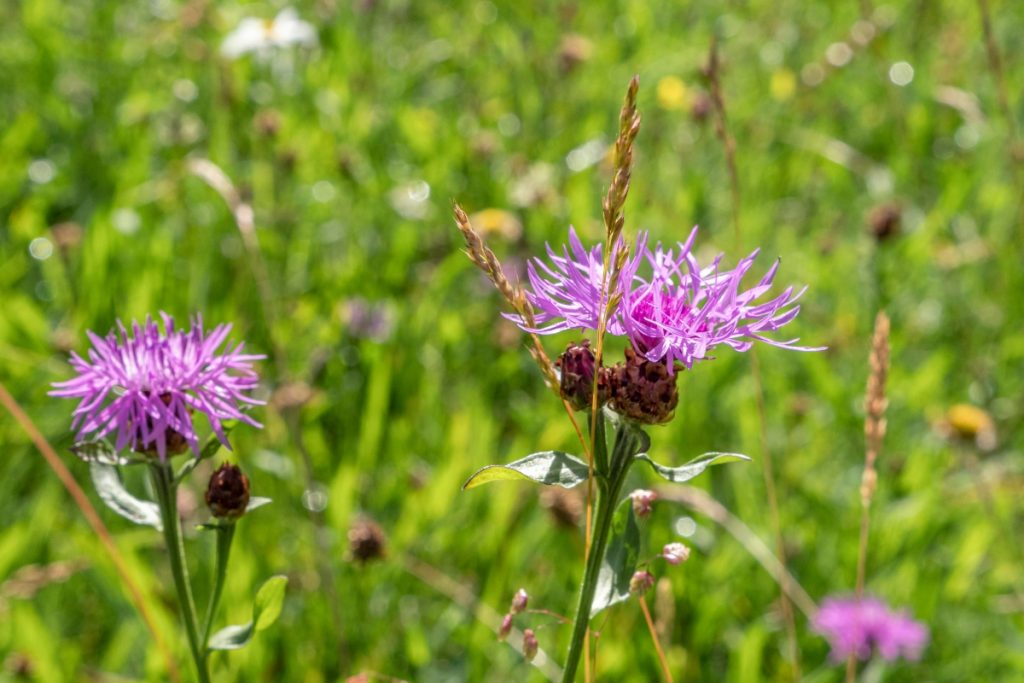
Ways to Use Canada Thistle
It’s a good idea to know how to make use of this prevalent, spreading weed. A great place to start is the leaves or, rather the leaf midribs. Harvest the leaves and strip off the spines on the outer edges. The spineless midribs have a celery-like flavor and can be eaten raw or cooked. You may want to use gloves until you get used to picking them.
You can also use the stem in a similar fashion. The stem is only good in the spring and early summer while it’s still soft and easy to bend. Later in the season, it can be tough and woody. To process it, peel off the leaves and outer skin. It can then be eaten raw or cooked in stir-fries and other dishes. It’s rather soft and has a pleasant, sweet, mild flavor.
Though Canada Thistle has smaller, more fibrous roots than other thistles, you can still harvest them for culinary purposes. They’re generally fairly easy to clean and can be eaten raw or cooked, like parsnips, carrots, and other root vegetables.
Additionally, you can use the inner flower bud as a substitute for artichokes. Artichokes and thistles are actually closely related. Before the flower has opened, you’ll need to peel back the spiny outer layer to reveal the tasty heart.
Canada Thistle is also used to flavor a few herbal gins that are now available. You may experiment with making your own extracts or flavored herbal alcohol.
You can also use Canada Thistle for internal medicinal preparations. Though the whole plant is edible, the roots and flowers are typically what’s used for medicinal preparations. You can make decoctions, tinctures, teas, and pastes with the roots and flowers to treat toothaches, liver, and digestive issues. Use these Canada Thistle preparations with caution as they have also sometimes been employed as emmenagogues, emetics, and diuretics.
Historically, the downy seed pappus of Canada Thistle was also a valuable part of the plant. It was used as down for insulation or stuffing, and reportedly, the Cherokee used it to fletch blowgun darts.
I think the young, unopened buds would make good wild foraged capers too.
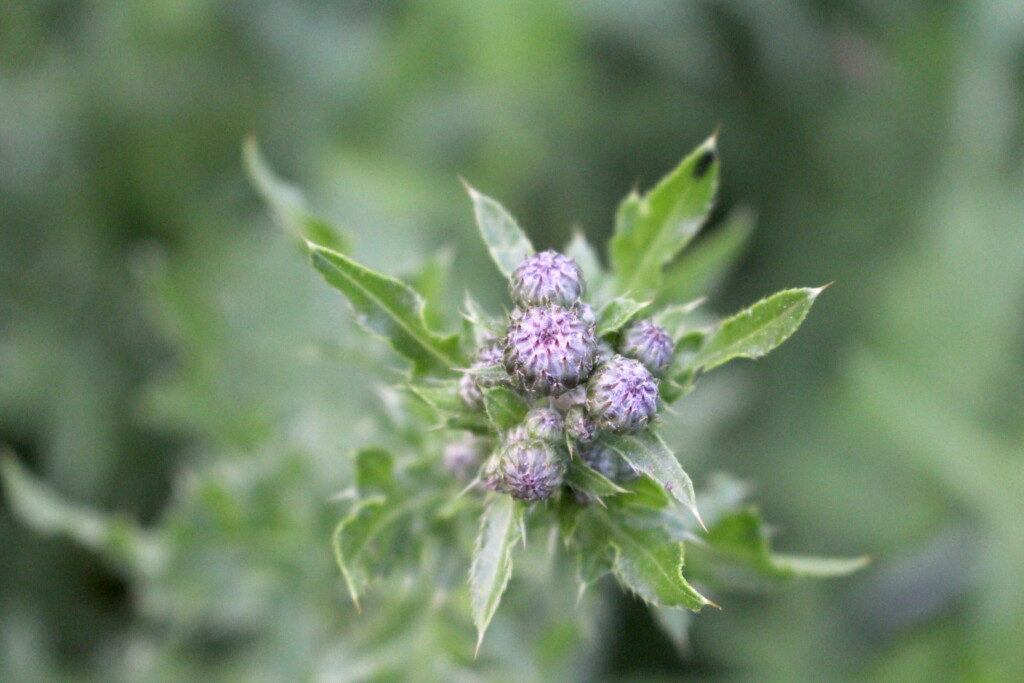
Canada Thistle Recipes
- Up your wild food game with this delicious recipe for Thistles Au Gratin with Truffles from Botanical Online.
- Harvest Canada Thistle leaves and try this Thistle Puree recipe from Deep Wood Dietitian for use in smoothies, soups, mashed potatoes, dips, and more.
- Looking for a sweet way to use Canada Thistle? Create this magical Thistle Blossom Jelly from Enchanted Living Magazine.
